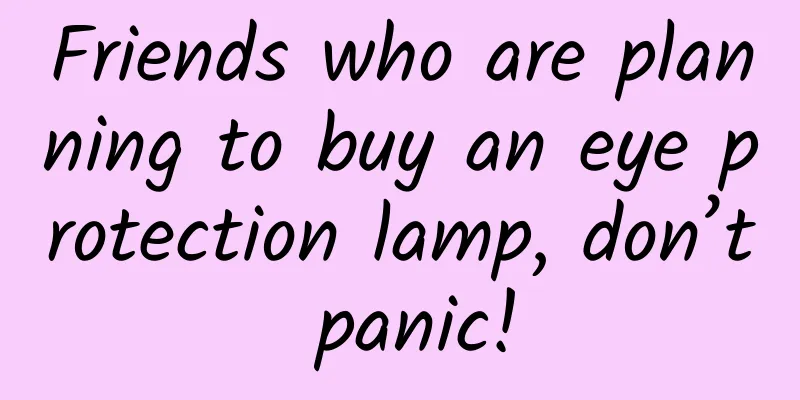Friends who are planning to buy an eye protection lamp, don’t panic!

|
Nowadays, people are paying more and more attention to their vision health, and there are various types of eye protection lamps on the market. Can eye protection lamps really protect eyes? What effects will different colors of light have on our eyes? Let me tell you about the things about eye protection lamps. Image source: soogif 1. What does a qualified eye protection lamp look like? In fact, this statement is relative. On the basis of reasonable use of eyes, using qualified eye protection lamps produced by regular manufacturers is beneficial to protecting our eyesight. So what kind of desk lamp can be called a qualified eye protection lamp? We currently believe that the most ideal eye protection lamp is a desk lamp that can simulate natural light and create a good lighting environment. Image source: Paixin Creative When the lighting environment we are in is too dark, the pupils of our eyes will naturally dilate in order to take in enough light. At the same time, in order to see the fonts on the book more clearly, our heads will unconsciously droop, causing the distance between the eyes and the book to be too close. If we use our eyes at such close range for a long time, our ciliary muscles will spasm. If the eyes are always in a tense state, the eye axis will lengthen, leading to the occurrence of myopia. When the lighting environment is too bright, it is easy to cause glare. In order to avoid excessive light intake, our pupils will shrink rapidly. Excessive stretching or contraction will lead to a decrease in the eye's ability to adjust. Being in a glare environment for a long time will also cause problems such as eye fatigue, soreness, and myopia. Image source: Paixin Creative Therefore, choosing a comfortable and eye-protecting eye lamp is very important for each of us, especially for teenagers and children. A qualified eye lamp generally has a soft light, not too dark, and will not cause a glare to the eyes. It can effectively relieve myopia or eye fatigue and can also protect the eyes. 2. What are stroboscopic light and blue light? Flicker refers to the periodic change of light intensity and brightness over time. Except for some special applications, flicker of light sources will have adverse effects on people in most cases. People who are in a severe flicker environment for a long time are prone to vision problems such as decreased vision, headaches, eye swelling and soreness. Therefore, flicker is an important factor in measuring the quality of light sources. Image source: CCTV "3.15" Gala In addition to flicker, blue light content is also an important evaluation criterion for the quality of light sources. Long-term exposure to harmful blue light can cause damage to the cells of the fundus. In particular, high-energy short-wave blue light with a wavelength of 415 to 455 nanometers can reach the retina through the cornea and lens, which can easily lead to age-related macular degeneration, cataracts and other eye diseases. In addition, shorter wavelength blue light, under normal circumstances, will focus in front of the retina after refraction by the lens, so long-term exposure to harmful blue light can also lead to visual fatigue and worsening of myopia. For people who often go out, the main source of blue light is sunlight; indoor artificial blue light sources include fluorescent lamps, light-emitting diodes and electronic devices. Display screens. Studies have found that blue light between 480 and 500 nanometers has the effect of adjusting biological rhythms, which is related to sleep, mood, memory, etc., and is beneficial to the human body. Therefore, it is very necessary to use anti-blue light lamps for our work and study. Image source: Yitu.com There are many eye protection lamps on the market with different prices, and even very different prices, but they all state on the outer packaging: no flicker. Most of the lighting lamps we use normally use 50Hz AC, which does have flicker. How to detect whether the eye protection lamp has flicker? A relatively simple method is to take a photo with a mobile phone. When the mobile phone camera is aimed at the eye protection lamp, a striped flicker phenomenon will appear on the mobile phone screen. The more obvious the flicker, the less recommended it is for parents to buy it, and try to choose flicker-free ones. In addition, many LED eye protection lamps on the market are "rich in blue light", that is, they contain more blue light components, especially harmful blue light, which may affect human eyes. For testing the radiance of blue light hazards, when we choose a desk lamp, we must ask the merchant to provide a photobiological safety monitoring report, from 100W/(M2.sr1) to 0W/(M2.sr1), the smaller the value, the better. 3. Different colors of lights Color temperature determines the color of light. The higher the color temperature, the colder the light. Conversely, the lower the color temperature, the warmer the light. This is why we often say "warm light, cold light, and natural light" in our daily lives. So, what color temperature values are used to divide these light colors? What different scenes are suitable for lights with different color temperatures? Image source: Paixin Creative Usually, we divide lights into three types according to their color temperature: warm light, cold light, and natural light. At present, the color temperature of desk lamps is between 2700K and 6500K. Below, we will interpret their parameter ranges and applicable scenarios respectively. Warm light is also called warm yellow light, with a color temperature below 3300K, generally around 2700K. Warm light is similar to incandescent light in color, with more red light components, which can give people a warm, healthy and comfortable feeling. It is suitable for homes, residences, dormitories, hotels and other places, or places with relatively low temperatures. Image source: Paixin Creative Natural light is also called intermediate color, and its color temperature is between 3300K-5300K. Natural light is soft, making people feel happy, comfortable and peaceful. It is generally recommended to choose a light source with a color temperature of about 4000K. 4000K can make people concentrate and be comfortable. The color temperature of sunlight from 8:00 to 10:00 in the morning is 4000K, which is suitable for stores, hospitals, offices, hotels, restaurants, waiting rooms and other places. Image source: Paixin Creative Cold light is also called daylight color, with a color temperature above 5300K. It has a bright feeling and makes people concentrate, but it is easy to cause visual fatigue over time. Therefore, cold light is suitable for offices, conference rooms, classrooms, drawing rooms, design rooms, libraries, exhibition windows and other places. Image source: Paixin Creative 4. How to choose a good eye protection lamp? 1. Give priority to desk lamps that can simulate natural light We all know that two hours of outdoor activities every day can effectively control the development of myopia in adolescents and children. It can be seen that "sunlight" has a very important impact on the vision of adolescents. The simulated natural light technology in the desk lamp simulates the outdoor lighting environment through a special processing process, so that it can restore the beneficial spectrum of sunlight to the greatest extent, protect the eyes, and prevent visual fatigue even if the eyes are used for a long time. At the same time, it puts the eyes in a better state of adjustment and relaxation to prevent myopia. Image source: Paixin Creative 2. The illumination meets the national standards In addition to "simulating natural light", we also need to pay attention to the "illuminance" level of the desk lamp. The illumination of a desk lamp refers to the luminous flux per unit area, which simply means whether the brightness of the desk lamp is good or not. If the illumination is particularly narrow or too bright or too dark, it will cause the pupil size of teenagers to constantly adjust to adapt to the illumination, which can easily cause visual fatigue. The country has clear standards for the illumination of eye-protection desk lamps: the national A level is the standard, and the highest is the national AA level. It is recommended to buy desk lamps with illumination that reaches the A-level standard or above. The illumination of the A-level is at least 300lx in the central area and 150lx at the edge; the illumination requirements of the AA level are at least 500lx in the central area and 250lx at the edge. In addition, the illumination uniformity must also be good. Image source: contracted photographer/IC photo 3. Adjustable light source color temperature The warmth or coldness of light refers to color temperature. The colder the light, the higher the color temperature. High color temperature will help you concentrate, but it is easy to cause eye fatigue and may cause damage to your eyes. The lower the color temperature, the warmer the light, but it is easy to make people sleepy and may affect their concentration. Therefore, when choosing a desk lamp, you should also pay attention to the "color temperature" indicator. Choose a desk lamp with adjustable color temperature. It is best to adjust the color temperature to around 4000K for daily use. Image source: IC photo 4. Color rendering index Ra≥95 is preferred The color rendering index (Ra) of a desk lamp is also an important indicator. It refers to the color rendering ability of a light source for an object. Sunlight is the light source with the best color rendering. The International Commission on Illumination (CIE) sets the color rendering index of sunlight at 100. The closer the Ra value of a desk lamp is to 100, the better the color rendering. It is generally recommended that the color rendering index be greater than 80. The better the color rendering, the higher the degree of color restoration of the object. Many people will become insensitive to colors if they are exposed to low color rendering light for a long time. Therefore, an eye-protection desk lamp with a color rendering index of Ra ≥ 95 can help us learn and draw more easily and accurately. Image source: Paixin Creative Of course, the above four points are just basic requirements. If you want the desk lamp to be more eye-friendly, it must also pass the national CCC certification, have no visual flicker, and no harmful blue light (RG0). You must pay attention to identification when choosing. Author of this article: Xuanyu, deputy chief physician of ophthalmology at Chongqing Wodi Ophthalmology Clinic. Former deputy director of ophthalmology at Daping Hospital of Army Medical University. Statement: Except for original content and special notes, some pictures are from the Internet. They are not for commercial purposes and are only used as popular science materials. The copyright belongs to the original authors. If there is any infringement, please contact us to delete them. |
<<: Beware! Chronic fatigue syndrome may bring big trouble! Check to see if you are infected
>>: Scary! The beef I just bought is "jumping"! Is it a parasite?
Recommend
Product operation: new user activation rules!
The traffic dividend has slowly faded away. From ...
20 versions of "fakes" without the original's true appearance? Scientific restoration reveals the mystery of the masterpiece
The exhibition "Frankness and Reality: The A...
European Commission: Artificial Intelligence and the Future of Work
The European Commission has released "Artifi...
When increasing user growth, how can we retain new users?
Retention of new users is a very important part o...
A woman suffered from scrub typhus and respiratory failure, just because of petting a cat?
Recently, a woman in Guangdong went to the doctor...
Why mobile phone screens tend to fail in winter
Why is the touch screen sometimes not very sensit...
Flame Encounter! The correct way to find fireball meteorites on the road, will this be possible?
How scientists found a rare fireball meteorite on...
The partner of Poison Tongue Movies personally teaches the "TikTok Hot Content Fan Growth Course" and discloses the secrets of fan growth for the first time
Training course content: 50 million big Douyin ac...
Ferrari hybrid supercar LaFerrari will be mass-produced in 5 years with 10,000 units
Ferrari has always been synonymous with top-level...
Short video ads are very popular, the key is how to get users to pay for them!
Since mid-2016, short video feeds and Native Ads ...
Traditional cultural knowledge supporting Qingming Festival: the structure of the underworld!
Mixed Knowledge Specially designed to cure confus...
iQIYI leads the qualitative change of TV content; Asia's first 4K Dolby Vision HDR online variety show goes online
On March 14, the pilot episode of the online vari...
A Quick Look at Internet Marketing and Analytics Terms
Based on the feedback from students in previous c...
How to transport the long wind turbine blades up the mountain? Here comes the answer
Some time ago, a video of builders transporting 7...
How does Zhurong cope with the winter on Mars? The engineering team explains
According to the Lunar Exploration and Space Engi...









